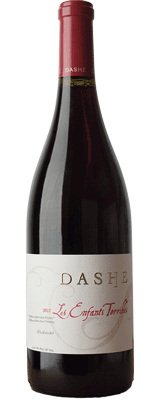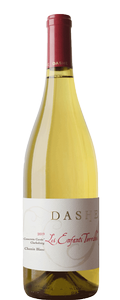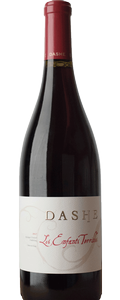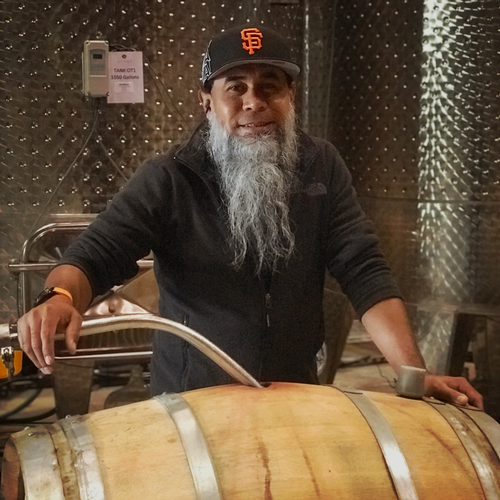The Dish @ Dashe
Fish Tales and Monkey Business from the Team at Dashe Cellars
 Mike Dashe Co-founder & Director of Winemaking
Mike Dashe Co-founder & Director of Winemaking
 Anne Dashe Co-founder
Anne Dashe Co-founder
 Rene Calderon Winemaker
Rene Calderon Winemaker
 Monica Chappell Wine Club Manager
Monica Chappell Wine Club Manager
Tasting with Rene | 2017 Sparkling Wine, Methode Ancestrale
A brand-new wine to Dashe Cellars, this ancestrale methode sparkling wine is otherwise known as a 'Pet Nat'. We've aged this wine in the bottle since 2017, long aging in the bottle alongside the native yeast contributes to its nutty, almost cider-like aromas and flavors. A perfect wine for pairing with strong cheeses and nuts, or simply enjoying a glass with friends!
Spring has Sprung at the Winery
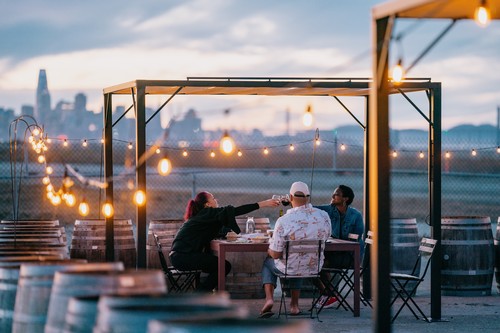
Well, Spring is finally here and with some luck, we’ll have been through the worst of this last year and starting to be (relatively speaking) back to normal. Not a minute too soon. We’ve all endured one of the most trying years of our collective lives, and now that the days are longer and lovely Spring afternoons are warming us, it’s our fervent hope that all of you are feeling better and are optimistic about the future.
We really can’t say thank you enough to have supported us during the most difficult year in our 26 years in business. One of the best things that emerged from this last year was that we discovered how much people have enjoyed the City views and the bird sanctuary in front of the winery on our City View Patio. We’ve loved having you come out and share this outdoor space with us, drinking wine and enjoying food from our food truck purveyors. Your spirit and enthusiasm has sustained us here at Dashe and we certainly wouldn’t have survived this last year without you to help us through it.
Amazingly, now we’re making our plans for this upcoming harvest. Bud-break has happened in the vineyards and the vines are starting to push out. Nothing like growing things to remind us that nature doesn’t wait for pandemics or politics—when it’s time to harvest, it’s time to harvest. We’re excited as always about the ripening grapes and our plans for upcoming wines.
–Best to you all, Michael and Anne Dashe
A Lighter Shade of Zinfandel, or My, How Times Change
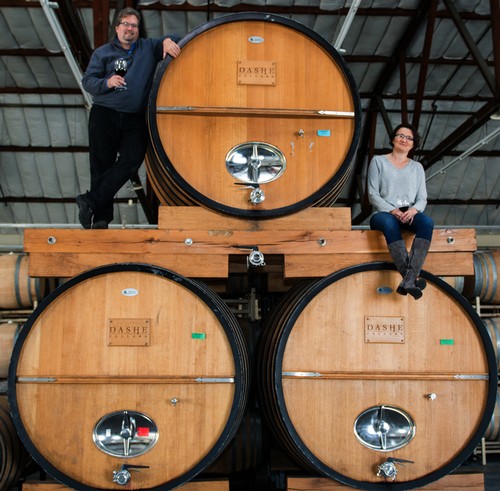
Last year, the wine writer Eric Asimov, long time New York Times wine columnist, wrote a two-part series for his Wine School column entitled “Revisiting Zinfandel from a Less Brawny Angle” and “Finding the Heart of Zinfandel.” The focus of the two articles was to taste three current examples of Zinfandel—all of which were a more modern, lighter, and less alcoholic styles—to see how recent styles of Zinfandel compared with the bigger, jammier, more alcoholic styles of popular Zinfandels from a decade or more ago.
Frankly, the focus of the article was that Mr. Asimov’s tastes had moved away from drinking Zinfandel a few years ago because of heavy-handed ripe flavors in some of the most popular zins. He was looking to see if recent offerings from wineries that made less brawny Zinfandels was more interesting and palatable, both to him and to his readers who commented on the wines.
Here at our little urban winery at Dashe Cellars, we were gratified that he selected a Dashe wine—the 2018 Zinfandel Vineyard Select—for his widely-read Wine School series. In the introduction, he said that “I selected the Dashe because I generally like this producer’s wines, they were fairly widely available, and the bottle was cheaper than the other two.”. We’ll take that—and we’re glad that Asimov enjoys our wines.
The Times have Caught Up with Dashe Cellars?
Personally, we were a bit amused by the premise of the article because it implied that it was only a recent development that certain wineries had moved towards making lighter, more elegant Zinfandels.
But those of you who know Dashe Cellars wines from when we started in 1996 know that we have always selected vineyards and used wine making practices to make lighter, more delicate, yet complex and balanced Zinfandels.
Although our single vineyard wines such as the Louvau Vineyard Old Vines Zinfandel has traditionally been less alcoholic than our peers, we really turned the Zinfandel world on its head in 2008 when we released our first “Les Enfants Terribles” single vineyard wine—a Zinfandel, naturally—from the McFadden Farm in Potter Valley.
Are we Drinking all 500 Cases Ourselves?
The first Les Enfants Terribles wine was a fluke, in a way, because it was a phone call from a sommelier—Mark Ellenbogen from the Slanted Door restaurant in San Francisco—that sparked the creation of this wine.
Mark was extremely diligent about which wines made his Wine List at the restaurant, and he loved softer European reds such as Gamay-based wines from Beaujolais region in France, and a wide array of Pinot Noir-based wines, also from Europe.
When the Slanted Door was criticized from some quarters for not having many domestic wines, Mark reached out to me and asked if it was possible if we might make a single vineyard wine that had many of the attributes he loved in his favorite European wines to go with the cuisine from the Slanted Door: lower alcohols; lower tannins; little or no oak influence; beautiful softer fruit character; a softer, velvety texture.
I had just seen the Zinfandel grown at McFadden Farm—a high elevation vineyard—and the red grapes were surrounded by Riesling, Pinot Blanc, and Gewurztraminer white wine grapes. I immediately loved the fruit flavors of the Zinfandel but was shocked at how light-colored the red grapes were. When Mark called me up, I said that I had found the perfect grapes to make a “Beaujolais-styled” carbonic maceration wine.
We had just purchased a 900-gallon oak foudre from Burgundy, and decided we would make all of the Zinfandel in the vineyard, and age it in this huge single barrel.
When we made the wine, using the carbonic maceration technique of whole berries and whole clusters, the wine was gorgeous, but the color was so pale red that it looked like a Gamay or Pinot Noir. I was so shocked that I turned to Anne and asked “are we going to have to drink all 500 cases of this wine by ourselves?” She turned to me and said “you’re crazy. This is exactly what I had in mind when we made this wine. People will love it!”
Click Here for 2017 Zinfandel, Mendocino Cuvée
We’ve Been Making Trendy Wine for 26 Years!
I shouldn’t have been so worried. The first Les Enfants Terribles 2007 Zinfandel from the McFadden Farm went on to become a tremendous hit at the Slanted Door, and soon word got around that Dashe Cellars was making this carbonic maceration Zinfandel that tastes unlike any other Zinfandel on the market. The wine became a darling of wine drinkers around the country who liked European wines for their balance and lower alcohols but wanted the vibrant fruit of a California wine at the same time.
Compared to many other Zinfandels out on the market, Dashe Cellars Zinfandels are lighter in style and have a certain balance between fruit and acid, with less oak and tannin on the finish. We’ve been making Zinfandels in this style from when we first released a single vineyard wine—a 1996 Dry Creek Valley Zinfandel—and have kept this signature style since.
It used to be that very few wineries were making wines that were lower alcohol and fermented on native yeast. No more—it’s quite common for new wineries to make wines in this style. We are pleased that after all these years following our heart, making wines that had a balance of an “Old-World” wine, our style is now very much on target for young, innovative wine makers.
We are huge believers in making wines that reflect the vineyards, and our style champions this type of artisan wine. Many thanks to Eric Asimov and other wine writers that now are highlighting our style of wine to a broader market of wine drinkers. For 26 years we’ve made wines that are now touted as “trendy,” due to their restraint and balance. We might not be a new winery, anymore, but we’ll take the trendy label anytime, as long as people enjoy the wines.
Dashe Cellars, Artisan Wine Making, and the Loire Valley: A French Connection
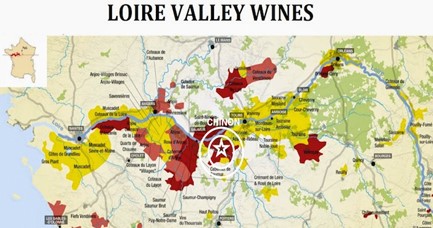
Back in 1995, before Dashe Cellars was a gleam in the eyes of Michael and Anne Dashe (and back when Anne’s name was Anne Bringuet), a visit to Brittany France, Anne’s homeland, was a revelation.
It started with the cuisine—creperies that were on almost every corner; oysters that were plucked right out of the river and eaten in front of your eyes; the freshest langoustine and fish you’ve ever tasted; butter that crunched in your mouth from embedded salt crystals; Kouignman and croissants so delicate that they melted in your mouth. The food simply was spectacular.
But beyond the cuisine, there was artisan wine. First, I was surprised to learn, there wasn’t any local stuff. There are no grapes grown in Brittany (to speak of). Lots of apple cider that went beautifully with crepes, but no Bretagne natural wine.
Instead, there were the wines of the Loire Valley, a scant 2 hours away from Brittany at its closest edge. To be honest, I didn’t know much about Loire wines. I had worked in Bordeaux, visited Burgundy, the Rhone, Champagne, the Jura. But the Loire? It was a place I knew about because of Sancerre and Poully-Fuisse, and I knew that Vouvray existed. That was it.
What blew my mind, in retrospect, is that the stores in Brittany were just filled with amazingly inexpensive bottles of Loire wines that I had never imagined. Just a few euros (francs at the time, but who’s counting) would buy you a great bottle of wine in the local supermarket. Whites from Montlouis and Touraine, beautiful light reds from Chinon and Bourgueil, crisp dry white wines from Muscadet. For a bit more, you could have beautiful complex wines from the hills of Sancerre, a balanced and age-worthy Vouvray or Savennières, or a luscious red from Saumur.
We devoured lots of Loire wines, every time we came out to visit Anne’s family in Brittany.
Dashe Chenin Blanc Makes its Debut
Years after that first introduction to the wines of the Loire Valley—and after we had started Dashe Cellars—we became dedicated drinkers of Loire wines.
We especially learned to love the many aspects of Chenin Blanc, a varietal that had a terrible reputation in the US (mostly because of years of uninteresting white wines made from huge vineyards in the Central Valley of California). The more we looked at wines made from Chenin, the more we learned to appreciate the spiciness, acid balance, and texture that make it one of the great varietals of the world.
At Dashe Cellars, the focus had mainly been on red wine varietals, except for a wonderful little Riesling that we had made, since 1999, from organic grapes on the McFadden Farm. We had made a conscious decision not to make Chardonnay (too many Chardonnays made in CA!), but our customers were constantly saying that they wanted us to make another white wine. We thought about what kind of wine WE liked and decided that if we ever were to find a region and vineyard with excellent Chenin Blanc grapes, we would try our hand at it.
Luck came our way in the form of the Heringer vineyard in Clarksburg, CA. This region has one of the largest concentrations of Chenin Blanc vineyards anywhere in the state. The reason is wildly logical: the local government paid for a soil and vineyard consultant to analyze the terroir of the region and recommend what varietals the area would be best to grow. The consultant came back with “Chenin Blanc,” which puzzled the local growers since it was not considered a top grape varietal. But to their credit, they started planting it and found that the resulting grapes and wine were of unusual quality.
Click Here to buy the 2019 'Concrete Cuvée', Chenin Blanc
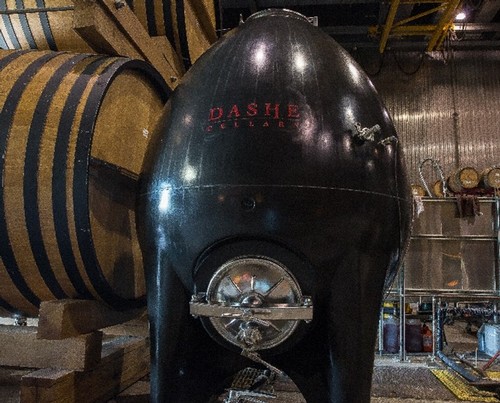
We Start Making Chenin Blanc: Black BART arrives
Dashe Cellars made its first artisan wine Chenin Blanc under our Les Enfants Terribles label from the Heringer Ranch in 2016. It was a hasty decision (we had just found the vineyard just before harvest) and came with another hasty decision: I wanted to make Chenin Blanc in a concrete egg. I had talked with other producers of Chenin Blanc, both in the US and in Europe, and there seemed to be a consensus that the complexity, texture, and aromatics of Chenin Blanc were all greatly highlighted when fermented as a natural wine, in concrete. We paid a ridiculous sum to purchase the perfect concrete egg (the price of impulsive buying), and the only one available so close to harvest was jet-black. They threw in a bright red DASHE logo for free, to make us feel better. We nicknamed it “Black Bart,” although really it looked more like Humpty Dumpty.
From the start, we wanted to make a “Loire-style” Chenin, whatever that meant. The goal was to have something with great texture, good acidity, lovely minerality, and a long finish.
We found that fermenting Chenin as an artisan wine in concrete and in stainless steel fermenters made a HUGE difference in the resulting wine. The same juice went into the fermenters, but the resulting wines may well have come from completely different places. The concrete fermented wine was quite different in texture (round, velvety, mouth-filling) and had toasty elements to the flavors, almost like champagne. We presumed that the egg-shape promoted lots of yeast contact during fermentation and aging, which (like Champagne) resulted in the characteristic toasty, fresh-bread aromas.
In contrast, the stainless-steel fermented wine had much more structure, almost steely, and was fruit forward. Together, the two lots made for an extremely vibrant, complex wine. We loved it.
In the end, we blended the two together to highlight the best parts of both fermentation styles and released it to customers who were delighted to have another white wine available from Dashe.
Cabernet Franc Rounded Out the Loire Valley Connection
We enjoyed the Chenin Blanc from Heringer vineyard so much that when we found out that they had a few rows of Cabernet Franc on their home ranch, we had to see if we could make a lighter-bodied Cabernet Franc—something in the style of a Chinon or a Bourgueil from the Loire.
When we first made the wine from these grapes, we simply couldn’t get our heads around it. It showed flavors of cassis and black cherry, which was lovely, but also had an edge of green olive and herbs, that simply was confusing to us when the wine was young.
We decided to put the wine into some nice French oak and waited until the next year or so to see how the wine would evolve.
Some time went by until, one day, Rene Calderon was racking the wine from barrel to barrel and we suddenly remembered that the wine was languishing in barrel without us tasting it for quite a while.
With no expectations, we tried the wine and looked dumbfounded at one another. In the past year, it had changed from a gangly child to a full-blown mature wine. Simply put, it was gorgeous and had nothing in common with the wine that we had tasted when it was in its youth.
This wine was filled with aromas of blueberries, and cherry, and spice. Just lovely. Anne remarked that it reminded her of some of the delicious and structured Chinon wines that were made from Cabernet Franc, which her family loved drinking when she was growing up.
We had gone from wondering if this was just a wasted experiment to asking ourselves how fast we could get it into bottle so that we could share it with our Dashe fans.
Click Here to buy the 2017 'les enfants terribles' Cabernet Franc
Here at Dashe Cellars, we have always been known for our Zinfandels, especially wines that reflect the combination of New-World fruit and Old-World balanced style. We’re proud of being standard-bearers for that style of Zinfandel.
But every once in a while, it’s great to get back to our roots and make wines that we fondly remember from when we first met. The wines of the Loire are never far from our hearts, and these versions of Chenin Blanc and Cabernet Franc are some of our favorite wines in the Dashe Cellars lineup of wines. They are often our go-to wines when we come, tired from work, to pop open a cork and relax, sipping, at the end of the day.
Interview with Winemaker Rene Calderon
Rene Calderon sat down with our DTC Manager, Stephanie Sawyer over a glass of wine recently (2017 Petite Sirah from the Todd Brothers Vineyard, one of Rene's favorites!). They talked about everything from his life transitioning from Mexico to Napa, California to building a career in winemaking. Toward the end of the bottle, they even started talking superpowers... enjoy the fruits of their hard work!
You have had quite an adventurous life! Starting in Mexico as a Philosopher and moving on to being a Winemaker in California. Can you tell me a little bit about your professional journey to get to this point, some of the steps that you've had on the way, and what inspired you to get into Winemaking?
Well sure, I landed in Napa from Mexico in 1996. It’s funny to me now that 1996 was the year that Dashe Cellars was founded and in that same year I arrived in Napa from Mexico. In Napa, there are two things that you do: you work in wine or you work with wine. I wanted to work with wine, in the production side of the business. I started working with Franciscan on the bottling line in the beginning of 1997. I worked on the bottling line for a couple of months and started moving up pretty quickly. In the nineties, there were a lot of production jobs available, so there was a lot of opportunity for growth. 1997 was my very first harvest working in the cellar; it was pretty easy work at the time. Digging out tanks, pumpovers, super-easy jobs, the very first jobs that they get you to do. You get a pump, you know how to use a pump, then do a pumpover and repeat it one hundred times. I loved the cellar, I loved the work and I still do. Once you learn how to do a lot of things, the work is very independent. I worked for Franciscan for about three years before moving on. Franciscan in a very large Winery, about half a million cases. At that point, I wanted to do more fancy, hands-on winemaking with a smaller producer. The winery that I moved to was Stags Leap Winery and they were making about 50,000 cases at that point.
I wanted to figure out if I really wanted to go back to school. In Mexico, I was studying to be a Philosopher, so I wanted to figure out if I was going to go back into this area of study and teach or if I wanted to do something else. Stags Leap was very small, the cellar crew was only five of us, plus the Winemaker and Enologist, I really liked working there. I really enjoyed working closely with the Winemaking staff, there was direct access to them. They oversaw all the work so I was able to see how they made decisions, how they worked with the wine, and they started to explain to me why things were important. This was a big influence on why I decided to go back to school and study Winemaking.
Spanish is my native language, so to dive deeper into the material I started with improving my confidence in English. My first ESL class was in 2003 at Napa Valley College and I transferred shortly to Oakland, I always wanted to live in Oakland. I love living in the city and I missed it when I was in Napa. I gained my transfer to UC Davis in 2008 and graduated 2010 with a bachelor’s degree in Viticulture and Enology. I had worked in the cellar for ten years before taking time off to finish my degree full time, the only vintages that I missed were 2007, 2008, and 2009.
After graduation, I started with Wente Vineyards in Livermore for the 2010 vintage. I ended up working at Wente because I still was living in Oakland and wanted to stick around. Wente offered me a position in the laboratory, which was something I had never done before; it was winemaking by the numbers. I was out of the cellar and it was completely analytical, I enjoyed being able to bring my knowledge of the cellar into the lab without the context, with just the numbers. That helped me to put a lot of the theory that I had learned into practice. I was with them for three years and became the Assistant Winemaker for Dashe in 2013. My first vintage as Winemaker for Dashe was in 2018. When I was in Napa, I wanted to work with the best people in Napa. When I moved my career to Oakland, that’s what I applied myself to do, I wanted to find the best people to work for. By the time that this position with Dashe Cellars opened, I had already been trying to make myself the most qualified person for the job. I knew about Mike and his connection to Ridge, and I knew that if there would ever be a position working with him that I needed to be prepared for it. I don’t just want to make good wine, I want to make the best wine.
For me it’s never been about the romance of the industry, it’s about the labor of it. I LOVE wine, I really enjoy it. And drinking lots it of course, but that came after my love of making it.
As Winemaker, you are given more freedom to be able to influence the final wines. How would you best describe your styles of winemaking?
First, I would like to talk about the difference between being an Assistant Winemaker versus being a Winemaker. As the Assistant, you are learning the techniques through the Winemaker, through listening about what they are looking to produce and how the achieve it. You work on the given project throughout the year and you follow the instructions. Once you learn enough, your own experience leads you to knowing how to get to the end result. As Winemaker, I have the experience to be able to do that, and this comes with responsibility and the trust that you gain working directly with the Winemaker. I’m still learning, you never stop learning and every vintage is different.
With regards to my style of winemaking, I would say that I make clean wines. To me, clean means no defects, sparkle, bright colors that you are only able to get with a lot of labor. Prior to Dashe, I came from more industrial winemaking, so working in the cellar with Mike and Anne and learning their process of non-intervention winemaking was eye opening. What you do in the cellar is very important to the final result. The fruit gives you the aromas, and the process in the cellar gives you the bouquet. Everything from the fermentation, the barrel selection, to the rackings and more. The aromas that natural fermentation brings with the yeast from the vineyard work really well without manipulation. I enjoy bringing together my knowledge from both sides of the industry, the industrial side and the non-interventionist side, in order to make the best wine possible.
With Dashe, I’ve been able to work with the different vineyards and showcase these places that all create wines that taste very different. When you can taste the difference between one vineyard and another, that is the sense of place, the terroir. That is what the vineyard gives and with Dashe I’ve been able to work on this more, on how to respect the place. You can't learn about this stuff unless you work closely under a Winemaker for a couple of years.
What wines stand out in your memory as the most influential to your work?
I love California wines. I like to study California wines because I work to make sure that I have the tools to be able to improve what we have access to here. I like Monterey Pinot; I like Napa Cab; I love Merlot: it’s one of my favorite grapes. Working in Napa, I was able to taste some of the best Merlots. The best wine that I’ve ever had was 2003 Shafer Merlot. I was at Stags Leap at the time and since we were neighbors, I traded bottles with them and was able to taste it right off the line.
I always look forward to seeing what delicious things that you’ve brought for lunch, it seems like you have an eclectic palate. Is there a cuisine or a style of cooking that you are especially passionate about?
I like eating a lot. If I was to pick a specific type of restaurant, I would have to give it some thought. I like sauces as well as super spicy food with crunch. Szechuan and obviously Mexican food, especially when it comes to meats. One of the things that I enjoy so much about Szechuan cuisine is that it’s so alien to me. I didn’t grow up cooking it or with any of the spices around. Every time that I taste it, there is something different and I like the experience of it learning about these flavors. I am always adding something new to the flavor library that I am building in my head. When it comes to the wine, there is always a wine to pair with Szechuan as well. For something that is really spicy, I would probably pair it with a wine that is jammier, something with high pH. I like to pair overwhelming flavors in food with big flavors in wine, something spicy with a chewy wine. Every new Szechwan dish I taste is amazing. Mexican food is similar in that aspect, each region has a different style. But in all truth, I eat whatever is in front of me.
I’ve been thinking a lot lately about different experiences of taste such as umami and spicy. When I say spicy, I mean the type of spice that you get in Mexican chilies. A secret of mine is that growing up, and even sometimes as an adult, I could drink an entire bottle of Valentina hot sauce. There is something about the acidity and spiciness of it, I will eat chips just to eat that salsa. I’m addicted to the sensation of it. It’s very similar to Szechuan mala, the scalding sensation that causes you to not be able to feel your mouth. I’m fascinated with the whole idea. The wasabi, mala, and chilis. These are all different forms of the experience of spice. It’s not about the aromatics or flavor, it’s about the physicality of taste. That’s what I really love about Petite Sirah, it’s the physicality of drinking. With this varietal and with other big wines, you really must tongue the wine, you have to slush your mouth around. I wish there were a wine that was really that profound in its aromatic profile, but for me it's all about the texture.
Do you have any advice for those that are looking to get into the production side of the industry?
Production is tough. There is a place for everybody in production, but make sure that you can work for 12 hours in a row. You’ll be wet, cold, and shoveling tanks out, but if you enjoy the idea of it then go for it. Production is not fun, but it is very satisfying. I like what I do a lot because it is very physical, it’s not romantic work but it is very rewarding work. To someone looking to get into wine production, I would tell them not to become enamored with the romance of it, instead look at what is actually means to work in the cellar. You have to really like the physicality of it, that’s what I really enjoy about the cellar. (interviewers note: I’m starting to realize why Rene has denied me a harvest internship for the past 3 vintages.) For someone starting out, I would recommend to work one harvest and if you enjoy it then stick with it.
What do you do when you aren’t working?
A lot! I enjoy reading comics and I spend a lot of time listening to audiobooks while I’m working. I go through probably 10 audiobooks between January and May, simply because it’s quieter in the cellar during that time. I like stories and hearing what people have to say, specifically fiction and high fantasy. Right now, I’m listening to Frankenstein, next I’ll move on the newest short stories by Stephen King. I spend a lot of my time in the music scene too, I go to a lot of heavy rock and roll shows. The funny thing about me? I like eating, I don’t cook. I love comics, I don’t draw. I love music, I don’t play. But I enjoy things for what they are, I like the creation. That’s why I’m so passionate about the winemaking, because I want to make sure that I can provide that kind of experience to the people who like to drink wine.
If you were to choose one superpower, what would it be?
Oh, I know this one, I’ve known it for a while. I would like the power of telekinesis. I would grab stuff from far away. Beer, come! Wine, come! Remote control, come! TV, on! Volume, down! I would get so much more done if I had this power.
Fall at Dashe Cellars
Well, we certainly have quite a bit to talk about these days, eh? As I write this, there are lightning-sparked fires, viruses, political campaigns, economic upheavals. What’s next, locusts?
One thing is for sure: we have learned to appreciate our friends and family more than ever. Our extended Dashe Cellars family has been an absolute source of joy to us these past months, keeping us busy during some dark times and filling up our new “City View Patio” at the winery every Saturday. Every day has been sold out since we opened again. Thank you!
For those of you who haven’t seen our patio, complete with 18 new “wine cabanas” for eating and drinking, we highly recommend it. Looks a bit like a cross between an art installation and a collection of tiny Stonehenge structures, with a killer view of the San Francisco skyline. (Except you can’t order wine in most art installations and can’t have food trucks like “Bacon Bacon” or Gerard’s Paella in them, either).
We’re weathering the storm as well as can be expected. Since we typically sell a LOT of wine to restaurants, we are suffering along with our restaurant friends. But our direct sales have definitely taken off, spurred on by “shelter-in-place” workers and our valiant Wine Club members who have stepped up to the plate and purchased wines to keep us afloat and their dinner tables full of delicious wines. Anne and I have been hand-delivering to the Bay Area, and have loved exploring all of these neighborhoods we would never have seen before. The East Bay is remarkably beautiful and diverse; we have been AMAZED at the beauty in the hills of Oakland and Berkeley.
And even though I can barely believe that I’m writing this, harvest is starting. (Sounds very “Game of Thrones” when I write it down, but it’s true.) Grapes are ripening fast, despite fires, pandemics, and elections. They wait for no one. So, here we go. Grape picking and crushing with masks; winemaking with threats of power outages; lots of cold beer to cool off the hot winemaking staff. Takes a lot of beer to make good wine. Ask any winemaker.
- Michael Dashe

